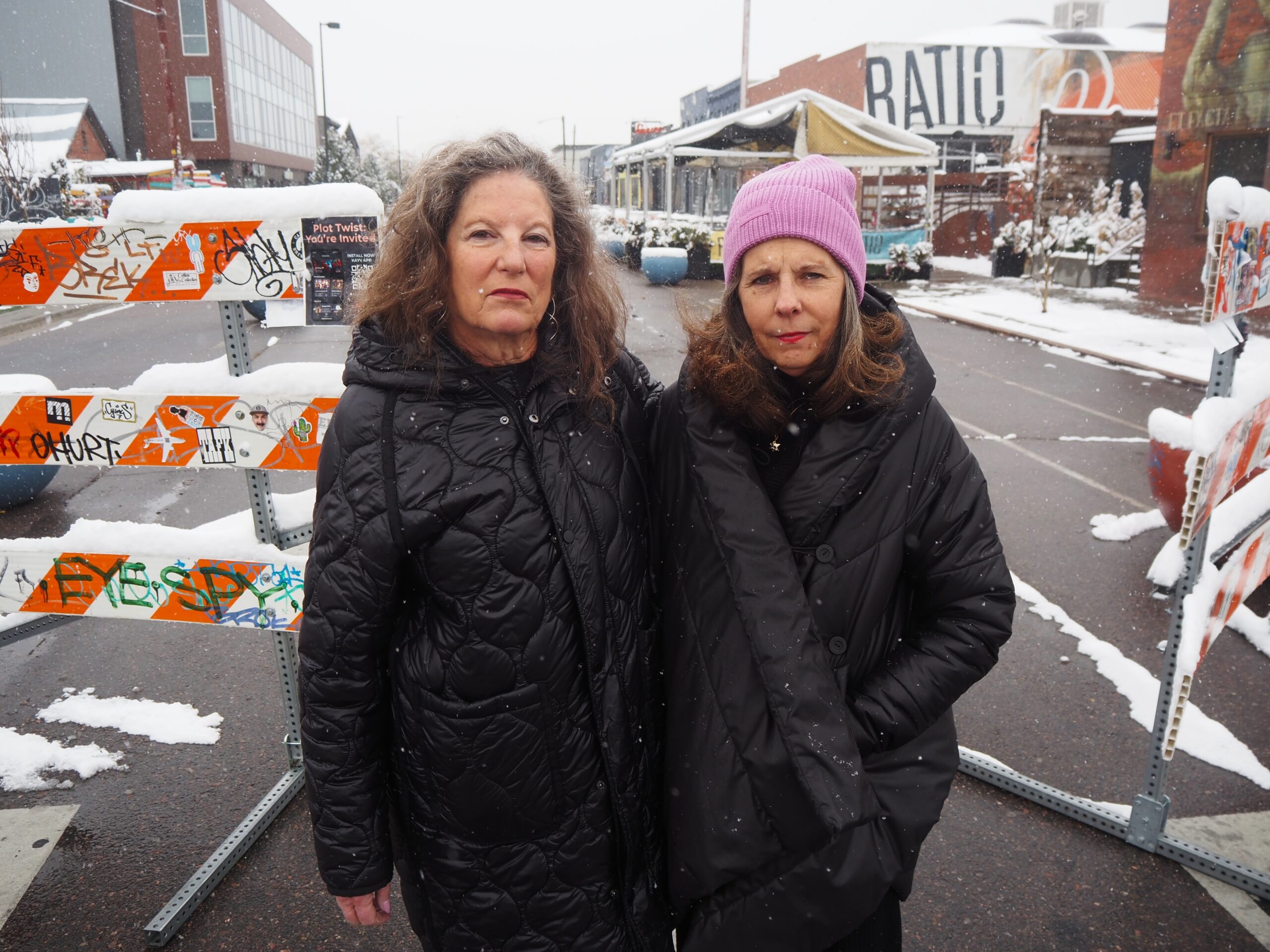
RiNo property owners Sonia Danielsen, left, and Tai Beldock stand in front of the 2900 block of Larimer Street, which is closed to vehicles, on Wednesday, Nov. 6. They oppose the closure. (Thomas Gounley/BusinessDen)
Tai Beldock and Sonia Danielsen consider themselves “founding mothers” of the RiNo business improvement district.
A decade ago, they lobbied their neighbors in the up-and-coming neighborhood to vote to create the district, which meant property owners would pay more in taxes. The money would fund shared services such as trash cans and marketing, intended to make the area a better place to do business.
“I walked the streets and asked people to give me their tax dollars, and I would be a good steward of it,” said Beldock.
The effort to create the BID was successful. But this year, with a vote looming on whether to renew the district for another 10 years, Beldock and Danielsen have a new objective.
They’d like to see the whole thing scrapped.
“The BID has achieved its original goals; it’s time to dissolve it and offer property owners necessary tax relief,” their online petition reads.
BID dollars managed by RiNo Art District
Beldock and her husband John own Erico Motorsports, a motorcycle dealership, which has been at 2855 Walnut St. since 1999. Beldock also runs the adjacent showroom for Embassy London shoes.
The couple own much of the property in the 2800 block of Walnut Street, including a parking lot and buildings they lease out. They also own a building at 2762 Walnut St., where Snarf’s Sandwiches is headquartered.
The Beldocks said about $20,000 from their annual property taxes currently goes to the BID.
Sonia Danielsen owns property in the 2800 block of Larimer Street and the 2800 and 2900 blocks of Blake Street. She said she has 10 tenants, including Our Mutual Friend Brewing and Bierstadt Lagerhaus, and pays $25,000 annually toward the BID.
In both cases, their tenants ultimately pay the property taxes, as is typical for commercial leases.
Their debate over the BID largely revolves around actions taken by the RiNo Art District, a separate organization that works to promote the neighborhood and, more specifically, its artwork.
When the BID was established, it had money coming in from property taxes. But it needed someone to manage and spend those funds. So the BID’s newly created board — which included Beldock and Danielsen at the time — voted to contract with the Art District to run it.
“Originally we hired them to do our accounting, our bookkeeping and the management-type things,” Danielsen said.
The BID’s annual budget was initially about $650,000, Danielsen said. But as RiNo property values skyrocketed over the past decade, the BID mill levy has remained the same, meaning the amount coming in has jumped sharply as well.
Too much of that, the pair said, is going to administrative costs.
“Back then, 15 percent of $650,000 was our management agreement,” Danielsen said. “Now, 27 percent of our $3.4 million budget is the management agreement. And that is the crux.”
Sarah Cawrse, co-executive director of the RiNo Art District, disputes those figures. She said administrative costs have always accounted for 20 to 30 percent of the BID budget. And she said administrative costs can vary based on whether the Art District hires an employee to handle a task or contracts it out.
Beldock and Danielsen have previously questioned the BID. Earlier this year, they got more than 30 property owners — including Kyle Zeppelin of Zeppelin Development, Brent and Brad Farber of Elevation Development Co. and David Zucker of Zocalo Development — to sign on to a letter calling for changes to the BID, such as the appointment of more property owners to the board.
But little, they said, changed in response.

The northern end of the closed stretch of Larimer Street last December. (BusinessDen file)
A closed block is just one thing that raises ire
Beldock and Danielsen’s scrutiny of BID spending goes beyond administrative costs. They question grants made to nonprofits with BID funds, saying an original BID focus on advocacy was supposed to mean advocating for things like making Walnut and Larimer streets two-way instead of one-way, a change ultimately made four years ago.
Plenty is spent on marketing, they say, but the Art District is emphasizing art, not businesses.
“If you pull up our Instagram and our website and our Facebook, all you see are pictures of spray paint,” Beldock said. “You don’t see businesses. You don’t see us trying to get butts in seats in all the different small businesses in the community.”
Beldock and Danielsen also don’t like that the BID has spent hundreds of thousands of dollars related to a one-block stretch of Larimer Street that has been closed since the pandemic. In their mind, the closure benefits only the handful of restaurants and bars in the 2900 block, which are essentially getting a huge outdoor patio that others paid for.
The pair think the closure harms the rest of the neighborhood because it makes it harder for motorists to navigate — and thus shouldn’t be supported with BID dollars. Others against the closure include Denver Central Market owner Ken Wolf and EXDO Group Cos. CEO Andrew Feinstein.
Sprung Construction owner Tom Sprung owns property in the 3000 block of Larimer Street, right by the closure, and told BusinessDen he pays about $20,000 annually to the BID. His real estate includes nearly 10,000 square feet of vacant retail space, and he believes the closure is keeping it vacant.
“My broker said, ‘I can’t lease this. There’s no traffic. Nobody sees the signs,’” Sprung said.
Sprung doesn’t even want to be his own tenant. He’s a franchisee of Wahoo’s Fish Taco, and said he’d, in theory, love to put a Wahoo’s in about half his vacant space. “But I’d be shooting myself in the foot without a street open,” he said.
Beldock said the businesses on the closed block should, at their own cost, expand their patio onto the sidewalk or on-street parking spaces, as a city program allows, and reopen the street.
“And if you need to close (the block) for a special event on the weekends, that’s fine,” Beldock said. “But things like the fire department, the police department, the UPS drivers, the postman, RTD — we lost a bus stop.”
Beldock and Danielsen are also disappointed by other things, including the RiNo Art District’s decision not to conduct a national search for a new executive director after the 2023 resignation of Charity Von Guinness. Instead, two staffers — Cawrse and Ayle Sharp — were named co-executive directors last December.
Beldock and Danielsen, who previously chaired the RiNo Art District board, said the pair lack experience in fundraising, which they see as an area where the organization lags.
The RiNo Art District does have oversight when it comes to its management of the BID — from the BID board. But Beldock and Danielsen, who are no longer on it, say the board doesn’t have enough property owner representation, and isn’t functioning independently.
“We feel that the management of the RiNo Art District is actually running the board, and so the board of the BID doesn’t really make a decision without the signoff of the executive director of the RAD,” said John Beldock, Tai’s husband.
Beldock noted she is not calling for the Art District to be disbanded.
“You guys can stay, you can have your website full of spray paint and you can have your Art Park,” she said, referring to a park off Brighton Boulevard that’s drawn BID dollars. “But I don’t want to be your piggy bank anymore.”
Keep the BID, but reduce the levy, other owners says
Not everyone critical of the BID believes it should be disbanded. Some are more focused on the mill levy, a sort of formulate that establishes how many tax dollars are sent the district’s way.
“I think it needs to be cut in half,” said Bernard Hurley of Menalto Development, who owns 7 acres on the other side of RiNo, including where Blue Moon Brewing operates.
Hurley said the BID has “taken on a direction that wasn’t intended.”
“They do what they feel like doing, and they’re not really listening to who’s paying,” he said.
Hurley said he feels like RiNo is falling off the national radar, citing an August “36 Hours in Denver” feature in The New York Times that hardly mentioned the neighborhood. The same feature in 2018 named numerous spots in RiNo.
EXDO Group CEO Feinstein, whose company owns the event venue ReelWorks and Tracks nightclub, also wants to see the mill levy reduced from four to two.
“I think the property owners in RiNo have already taken on enough burden,” he said.
Some believe that lowering the mill levy was always intended to be the BID’s plan if property valuations, and thus taxes, increased more than basic expenses.
“We, as founding mothers and fathers, always thought, while if the assessments go up, we’ll just lower the mills,” Danielsen said.
Sprung said he “basically got my arm twisted” into supporting the BID a decade ago.
“There were a lot of promises made that it was going to stay small,” he said.
If the BID is renewed, Beldock and Danielsen said, they think a budget of $1 million to $1.5 million is reasonable. And they’d like to sever the link to the RiNo Art District.
“I would like to be done with the management agreement. I would like the BID to have its own staff,” Beldock said.
BID board member: ‘At every turn, they’ve been involved’
In a joint interview on Tuesday, Cawrse, the RiNo Art District co-executive director, and Adam Larkey, a Zeppelin Development executive who sits on the RiNo BID’s board, defended the BID’s performance.
Both said they believe the concerns of Beldock, Danielsen and others have been heard.
“At every turn, they’ve been involved,” Larkey said.

Sarah Cawrse
Cawrse noted that the letter previously sent by Beldock and others said the BID needed to improve efforts to keep the neighborhood clean. So the Art District hired staff that sweep sidewalks and power wash, instead of just swinging through to empty trash cans.
“They are in the district every single day of the week,” Cawrse said, noting that change came with additional costs.
Cawrse said the current BID board “is a really good representation of the community,” and that creating a good business environment doesn’t necessarily mean doing exactly what property owners want.
“Ultimately, visitors are the people that are holding up our businesses,” she said.
Larkey noted that other BIDs in Denver have a higher mill levy. While RiNo sits at 4, Cherry Creek North is at 17.64, and the Colfax BID comes in just over 10, according to a state website.
“I would love to shift the conversation to more of an ROI conversation,” he said. “You can’t do it when you have your mill levy slashed.”
Both defended the block closure, pointing to a survey that found more than 90 percent of respondents in favor — a degree of support that Larkey called “a mandate.”
“There really aren’t many communal places in RiNo,” Larkey said. “It’s all thoroughfares.”
Cawrse also said that the closed block isn’t fully built out, and the BID’s decision to push for its closure is based on “that new improved condition” that is coming.
Larkey did allude to some Art District missteps when Von Guinness, who was selected after a national search, briefly led the organization, and said that the BID board for a time had “more of a reactive role than a proactive role.”
“When you have that kind of turnover, especially at the top, it trickles all the way through,” he said.
Cawrse said the Art District for a time both employed a chief financial officer and contracted with an outside accounting firm. It has since jettisoned the CFO.
But both said the organizations have and are correcting themselves, and having two people serve as executive director makes sense, given that the Art District straddles various worlds of art and development and city policy.
“It’s a complicated organization that represents an extremely fast-moving district, and so there are naturally going to be growing pains,” Larkey said.
BID renewal to be discussed at Nov. 13 meeting
A meeting will be held Wednesday, Nov. 13, to discuss the potential BID renewal. It will be from 5 p.m. to 6:30 p.m. at ReelWorks at 1399 35th St., with participation also possible by Zoom.
The board of the BID will then vote on Nov. 20 on whether to renew it. The proposed renewal will then go before the Denver City Council, which will have to approve it.
If Beldock’s wish does come true, and the BID is dissolved, she said she would “go around and I grab my two, three-block radius of neighbors.” She’d tell her closest neighbors that she’d take care of emptying the trash cans for the blocks, she said, and they could pay her something.
She and her husband would also take the money they’d save in property taxes and hire a security firm to “go around the block on the weekends because we have some serious security and safety issues.” There was a fatal shooting in RiNo this summer, she noted. Her tenant Revzilla was broken into, as was Patagonia, which leases space two blocks away.
“I would form more of a neighborhood association and I would encourage other people to do the same,” Beldock said.

